Resources

Graduate schools produce a good number of well-educated women who then go on to become successful professors, published authors, and administrators in institutions of higher learning. Women in academe are expected to do it all, do it well, and have well-balanced lives outside the work place. Graduate schools do not prepare women for the numerous challenges they encounter in the various facets of academic life. This book identifies challenges and issues related to women’s lives in academe and suggests practical and studied tactics to help women thrive in the academic world and in their own lives. Rena Seltzer has extensive experience as an academic coach and has gathered a compelling amount of data and first-hand experiences from women professors. She acknowledges that surviving in academia is not easy, especially for women and under-represented minorities. Oftentimes, women feel isolated and are not aware that some of the challenges they face are not uniquely their own. By identifying such challenges, Rena Seltzer achieves the goal of bringing awareness to these common experiences. In addition to identifying these challenges at the different stages of academic life, the book offers a deeper analysis of the issues and obstacles of academic life as well as provides practical advice on how to overcome them. In ten chapters, Seltzer addresses the following topics: How to have more time; Establishing a productive writing practice; Teaching; Work-life balance; Networking and social support; Tenure, promotion, and the academic job market; Authority, voice, and influence; Negotiation; Life after tenure; and Leadership. The book includes numerous practical tactics, from how to phrase effective emails to how to say no to attractive projects and roles that would overtax an already crowded schedule. This ability to say “no” when appropriate leads to a more productive and balanced life, thereby reducing stress. Each chapter offers a variety of further sources the reader may wish to investigate. The author’s style is engaging and friendly, and her voice comes through as wise and reassuring. Chapters can conveniently be read independently, as fits the reader’s interest. While the book addresses topics shared by most women across academic disciplines, it can be particularly useful for faculty who teach religious studies or theology since these fields rely heavily on self-reflection and self-giving. The balance between such theologically and pastorally motivated attitudes and the demands of academic and non-academic life is especially challenging. Anecdotally, all female academics I have shared this book with have expressed great interest in it and admitted they would like or need to read it. One said, “I wish this book was around when I started out!” The book is recommended to all women in academia but also to any faculty at any stage in her or his career who is experiencing some of the same challenges.
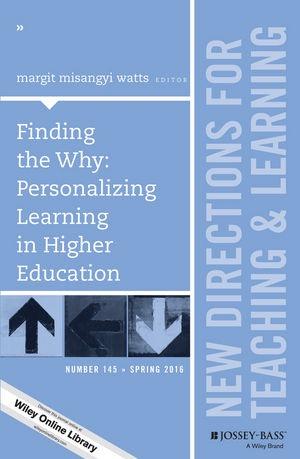
Whenever I’m asked, “How are your classes going?” my answer traditionally has been, “Ask the students.” As more faculty members shift their pedagogy to a student-centered learning, their focus must include not only delivering the content but also inviting students to explore the why of education. The articles in Finding the Why: Personalizing Learning in Higher Education edited by margit misangyi watts (sic), identify key ways to encourage students to discover the purpose of higher education as more than training for a career. While many of the articles describe institutional changes that have been developed to address the student success beyond the university, the principles behind such designs can be incorporated by individual faculty members in approaching how to present their courses’ content. One of the key principles is to encourage students to identify the applicability of a liberal-arts education to professional courses. One means by which this can be accomplished is described in “Integrative Learning: Making Liberal Education Purposeful, Personal, and Practical.” Ann Ferren and Chad Anderson describe several examples from various colleges that integrate learning across curricula and are adaptable even for larger institutions, such as designing opportunities for students to integrate curricula using collaborative projects, partnerships with the local community for service-learning, and making connections among disciplines. Furthermore, in “Project-Based Learning in Colleges of Business: Is It Enough to Develop Educated Graduates?” Penny Smith and Lindsey Gibbon note that business leaders are seeking qualities such as critical thinking skills, identifying and using creative problem solving, and communicating effectively. They note that “for business schools to graduate ‘well-educated’ students, they must forge and engage entire academic villages” (43) in preparing business students for their careers. Another important component of finding the why requires understanding the challenges in culture that affect the attitudes impacting student-centered education. Several of the chapters incorporate strategies to change the culture at institutions themselves to meet the ongoing challenges to student success. Among such recommendations are faculty “talking to students in a way that is supportive and encouraging” (29) or engaging in the six “P’s” of place, preparation, pathways, plan, purpose, and personal connection as explained by Sanford Shugart in “Why Higher Education: Lessons Learned in a Learner-Centered College.” While many of the articles describe specific activities involving changes within the entire institution, such as integrative classes or designing a community college’s plan from its inception, the authors do challenge individual faculty to incorporate helping students find the why within their particular courses. The key to student success in many of the articles involves engaging students individually, not just collectively. Therefore, some of the strategies discussed can be applied by individual faculty on a smaller scale. While my answer to “How are your classes going?” may be the same, my intentionality within my course itself should have students answering in the positive.
2016-17 Teaching Workshop for Early Career Theological School Faculty Designed for faculty members who are in their first years of teaching, this workshop will explore 21st century challenges in theological education, innovative teaching practices, and complex institutional ecologies. We invite applicants who are interested in joining a community of collaborative inquiry to wrestle with questions such as: What does it mean to teach disciplines differently? What does it mean to teach in ways that generate new learning? What does it take to (re)imagine pedagogies and curricula for responsible teaching in changing local/global situations and contexts? What does it take to navigate institutional cultures and realities in ways that are liberative and bring about wellness? The workshop will gather 14 faculty members for a week in two successive summers and a weekend winter retreat in Corpus Christi, Texas. There will be a balance of plenary sessions, small group discussions, workshop sessions, structured and unstructured social time, and time for relaxation, exercise, meditation, discovery, laughter, and lots of good food and drink. Goals To cultivate imagination for teaching that affirms the particularities of traditions, expand ways of knowing, and embrace the vitality of global perspectives To explore pedagogical practices that foster self-reflexive discovery, honor authenticity of voice and authority, bolster creativity and innovation, and yield potential for liberative change To sharpen personal capacity to navigate institutional cultures and realities in ways that integrate passion and ability, proactive agency, and strategic alliances for academic flourishing and advancement Honorarium Participants will receive an honorarium of $3400 for full participation in the three workshop sessions, plus local expenses and travel. Read More about Payment of Participants Read about our Policy on Full Participation Fellowships Participants are eligible to apply for a $5000 workshopfellowship.These awards are for projects that emerge from the conversation and ideas of the workshop, in consultation with the leadership team, and are conducted during the year following the workshop. Participants Front Row: *Gay Byron (Howard University School of Divinity), Carlos Cardoza-Orlandi (Perkins School of Theology, SMU), *Mai-Anh Le Tran (Eden Theological Seminary), *Dwight Hopkins (University of Chicago Divinity School). Second Row: Angela Parker (The Seattle School of Theology & Psychology), Carolyn Browning Helsel (Austin Presbyterian Theological Seminary), Sharon Jacob (Phillips Theological Seminary), Leanna Fuller (Pittsburgh Theological Seminary), Sophia Park (Neumann University), Timothy Hartman (Columbia Theological Seminary), Deanna Ferree Womack (Candler School of Theology – Emory University). Third Row: Julián Gonzalez Holguin (Church Divinity School of the Pacific), Danjuma Gibson (Calvin Theological Seminary), Adam Ghali (Fresno Pacific University), Michael Chan (Luther Seminary), Peter Anthony Mena (Phillips Theological Seminary), Lisa Bowens (Princeton Theological Seminary), Daniel Shin (Interdenominational Theological Center), Paul Myhre (Wabash Center). *leadership/staff APPLICATIONS CLOSED Workshop Information Dates First Session: July 11-16, 2016, Wabash College Second Session: January 19-22, 2017, Corpus Christi, Texas Third Session: June 12-17, 2017, Wabash College Policy on Full Participation Leadership Team Mai-Anh Le Tran, Eden Theological Seminary, Director Gay L. Byron, Howard University School of Divinity Carlos F. Cardoza-Orlandi, Perkins School of Theology, SMU Dwight N. Hopkins, University of Chicago Divinity School Paul O. Myhre, Wabash Center Important Information Policy on Full Participation Map of Wabash College Campus Travel Reimbursement Form (pdf) Foreign National Information Form (pdf) Payment of Participants Fellowship Program (2016-17) For More Information, Please Contact: Paul O. Myhre, Associate Director Wabash Center 301 West Wabash Ave. Crawfordsville, IN 47933 800-655-7117 myhrep@wabash.edu
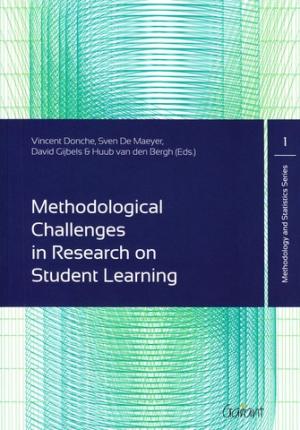
The central aim of this edited monograph is to present new techniques for dealing with methodological challenges to sociological research on student learning. The book is organized into a brief preface, seven chapters that each deal with distinct methodological approaches to student learning research, and an eighth chapter that provides an outline for how the preceding chapters can be applied to or help shape future research. Each chapter presents various solutions to distinct methodological challenges through concrete case studies. Chapter one provides an overview and case study of how structural equation modeling (SEM) can be used to conduct empirical research that tests hypothesized influences on student learning. The authors contend that previous research has not been able to fully address the complex multi-variable character of students’ approaches to learning. The strength of SEM is not only its ability to test for multiple variables such as these, but also to examine the pattern and strength of the relationships between these variables. Chapter two explores challenges to research on students in dual programs composed of both university classes and internships. The goal of such research is to take into account the different perspectives, discourses, and research instruments (for example, focused in-depth research and large scale qualitative research) used to study dual program student learning, including workplace learning and the transitions between contexts of learning, learning in higher education and its specific learning activities and patterns, and longitudinal professional development. To study such complexity, the authors propose the use of multilevel analysis for dealing with nested data and methodological triangulation for testing the use of the multiple research instruments. Chapter three outlines a method for using neural network analysis techniques for assessing the predictability of how much influence cognition, motivation, and learning approaches have on academic performance. Chapter four provides a model for addressing the failure of previous research to address implicit preferences for specific types of learning environments by using conjoint analysis, a method developed and employed in marketing research. Chapter five proposes exploratory-grounded research as a way of developing theories rather than solely testing them. The first case study provided in this chapter analyzes data from semi-structured interviews on students’ motivational orientation through various processes for identifying, verifying, and revising themes in the data. The second study then analyzes another set of interviews using the categories developed from the first study. A strength of this approach is its ability to develop innovative theories that are not limited to any pre-established or hypothesized number of categories. Chapter six addresses emotional dimensions and their measurement in research on teacher education. In addition to providing a thorough rationale, outline of theoretical perspectives, overview of the phenomenological method in social science research, identifying themes in the data, and discussing methodological challenges, the chapter provides a helpful survey in the form of a table of previous research articles that address emotional dimensions. Chapter seven explores challenges to longitudinal studies and provides a model and short list of best practices. Though interesting conclusions and/or corroboration and challenges to previous theories regarding student learning are discussed throughout the book’s varied chapters, the overarching focus is indeed on methodological challenges and proposed solutions to these.

After teaching an introductory course on Islam for over ten years I still am fascinated that most students are unaware of what Sufism is and how Sufism has influenced Islamic metaphysics, societies, cultures, histories, arts, sciences, and trade. In addition to asking myself “Why is there such a lack of knowledge about Islam and Muslim societies?” I have also often asked myself, “Why is there such a disconnect in the minds of students when it comes to Sufism and Islam?” For this current blog and the two that will follow in the Autumn months, I will share some thoughts about teaching Sufism and contemporary Sufism. As readers of the Teaching Islam blog can attest, teaching and writing are interconnected. Many of us write books and articles to use as tools for our classes. Just this past summer, I completed with my co-author, Dr. William Rory Dickson, an introductory textbook on Sufism entitled Unveiling Sufism: From Manhattan to Mecca (available next year through Equinox Publishers). I also am currently writing with my co-authors Dr. William Rory Dickson and Dr. Merin Shobhana Xavier a manuscript entitled Contemporary Sufism: Piety, Politics, and Popular Culture (available next year through Routledge Publishers). The structure, approach and content of these books have influenced my teaching on Sufism, and my experiences in the classroom have influenced my writing. When teaching on Sufism, I find it helpful to “meet students where they are” with Islam, which means starting with the here and now. One way of doing this is to utilize a genealogical framework, in which the student begins to learn not with the historical past, but with the contemporary present: with the diversity of living Sufism in North America today, and ways in which Sufis feel pressure from “both sides” – from non-Muslims and Muslims alike, albeit for different reasons. Taking this approach enables the teacher to explore the growing anti-Muslim, post-9/11 sentiment among North Americans, as well as the intensification of anti-Sufi sentiments among some Muslims (explaining, for example, why Muslim extremists are destroying Sufi shrines). Students then can also examine the different interpretive tendencies emerging among Sufi communities in North America, including universalist tendencies that understand Sufism as something not limited to Islam, as well as more traditionalist perspectives that assert Sufism’s necessary connection to Islamic practices and laws. In addition, the students can learn Sufism’s remarkable influence on North American art and culture, notably through the 13th century Sufi personality, Jalal al-Din Rumi, whose poetry has inspired a variety of different tributes and interpretive expressions, in visual art, yoga, social activism, dance, music, and even in the restaurant and café business. By beginning with issues and themes found in the 21st and 20th centuries, students are then offered the complexities of Sufism as we collectively move deeper through time and space, journeying through a variety of historical, religious, political, and cultural contexts, further delving into the past, and closer to the “origin” of Sufism. This genealogical framework enables the student to understand the patterns of connection between contemporary manifestations of Sufism and past realities from, the bustling metropolis of 21st century Manhattan, to colonial Algeria, through medieval Delhi and Istanbul, back to Baghdad and ultimately Mecca – the birthplace of Islam and its mystical tradition. In addition to using a genealogical framework, it is important to help students explore Sufism as a multidimensional phenomenon. Sufism has influenced Muslim philosophy and metaphysics, but also politics, art, and culture in each historical period. Utilizing particular Sufi figures, movements, places, artistic expressions, or philosophical views, the student develops a richly contextualized appreciation of Sufism. For example, one teaching exercise that I have used is to compare the tradition of wandering mendicants or dervishes of Islam to the leaders of the medieval imperial courts. In such a comparison, I like to share with students the symbolic significance of specific items from material culture. For example, I like to bring to class a very elaborate kashkul from Lahore, Pakistan, as well as miniature paintings of medieval dervishes from Turkey and Iran. Another consideration when teaching on Sufism is to consciously integrate the contributions of women to Sufism, as well as the diversity of Sufism in different regions of the world. In order to avoid reducing the role of women to a subject for one class session, it is important to use women as examples in each historical era, drawing out numerous examples of Sufi women who have been engaged in politics, philosophy, arts, etc. Additionally, it is easy to use illustrations and case studies from the Middle East and South Asia, but it also is essential to help students explore Sufism in all regions of the world, especially Africa and Southeast Asia. There are many different ways to enliven the teaching of Sufism and to make the subject speak to contemporary students who enter the classroom with diverse interests and preconceptions. By engaging current concerns as well as pop culture manifestations of Sufism and then working backward in time toward the point of origin, it is possible to enable new ways of connecting with the subject matter. Such an approach also facilitates the introduction of perennial debates about Islam and Sufism in relation to current controversies, demonstrating continuity as well as change and diversity in Sufism throughout the centuries and opening student’s minds to Islam’s rich and varied cultural, intellectual, and spiritual heritage.
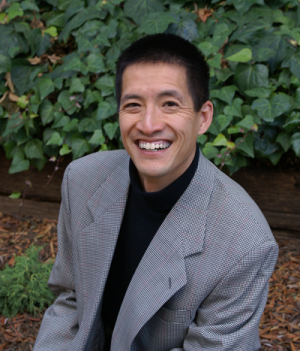
The University of Chicago made news recently because of a letter sent by its Dean of Students to inform its incoming class of freshmen that the University, given its commitment to “freedom of inquiry and expression,” does not support “trigger warnings,” cancel controversial speakers, or condone creation of “safe spaces.” Responses to this letter run the whole gamut from celebratory cheers to condemnatory curses. Some see this as the University’s honorable refusal to shut down difficult discussions of sensitive subjects; others see it as the University’s hypocritical and covert attempt to forestall student activism on campus to challenge conservative speakers or oppressive rhetoric. I have no way of knowing the “real” motivations or intentions of this letter. I do notice, however, that subsequent conversations, whether in support or in protest of the University of Chicago’s letter, tend to assume that “free speech” will necessarily trump or preclude “safe space” or “trigger warnings” without clarifying what those terms may mean or how they may be put into practice. As an educator who likes to encourage and enable students as well as myself to think again and think differently, I am all for free speech; free speech is, in fact, indispensable to classroom discussion and learning. We do not learn well if we feel like our thoughts and ideas are being suppressed; we also cannot learn if we are not allowed to make mistakes. Nobody’s commitment to Black Lives Matter, neither mine or any of my student’s, should keep white students in my class from articulating their disagreements with or dislike of James Cone’s Black Theology and Black Power. Similarly, advocates for LGBTQ rights, including myself, cannot silence students who want to push back against Marcella Althaus-Reid’s Indecent Theology. Every student in my classroom should have the space and time to express their thoughts and views, even if I think they are dead wrong; to deprive students of such is to take away from them an opportunity to hear and learn through feedbacks and responses. We must also not forget that persons from traditionally marginalized groups do make mistakes and can also be misguided in their thinking. Whether this commitment to free speech and the idea of the classroom being a safe space can coexist depends on what one means by the latter. I cannot guarantee that no one will feel uncomfortable, unsafe, or threatened in my classroom since I cannot control how one feels or deny what someone is feeling. Hearing new ideas that you have not considered before, especially if it contradicts or challenges what you have held dear deep down and for very long, can indeed be very alarming. I have also heard faculty of color and female professors saying that they themselves did not feel safe at times with their students. When students are even allowed to carry guns legally on some campuses, how can I feign the power or ability to keep everybody safe in my class? I can, however, promise that students in my courses will have a safe space to speak freely, meaning only that they will be able to say what is on their mind and in their heart, including saying, “I am feeling rather threatened!” or “I feel under attack and unsafe right now.” This kind of safe space is not one that shields students from being challenged, feeling offended, or experiencing wound or harm; it is, however, one that does not frame “free speech” and “safe space” as mutually exclusive by definition. Having a safe space to speak freely also does not, in my view and practice, necessarily cancel out the desire or the need for trigger warnings. A person does not have to run over other people verbally just because she or he has something important to say that others may find difficult to hear. I am not able to verify if it is true that persons of color, because of all the discrimination and marginalization, have developed thicker skins than average Whites, I will only say that some experiences, including oppressive and unjust ones, may also make someone more sensitive to other people’s feelings and she may hence become more thoughtful and more gracious about giving trigger warnings. Trigger warnings, when given clearly and concisely by a teacher on her own initiative in the classroom, do not function to shield students from but prepare students for difficult topics or challenging ideas. After giving a trigger warning, I have never once asked my students, “Is it okay to talk about this now?” or said to them, “You may leave the class if you do not want to hear or think any more about this.” More importantly, those of us who are teachers should remember that we have the responsibility to guide and guard the tone and the emotion of a classroom even or especially when we push for honest and genuine exchange of views and opinions. Let’s remember also that what we do may become models for our students to emulate. They, like us, need to learn how to disagree, debate, and argue passionately, thoughtfully, and respectfully. Instead of following or (even in dispute) allowing the University of Chicago’s letter to set the terms of the conversation, I see the possibility for “free speech,” “safe space,” and “trigger warnings” to exist alongside each other in my classroom and in my universe. Oh, one more thing: While a school can—and should—refuse to cancel an invited speaker with controversial viewpoints (whether the speaker is Ann Coulter or Jeremiah Wright), students and teachers can also continue their activism to speak freely against what they understand to be unjust or unacceptable. The point of activism is not to shut people up or shut people down, but to push for rethinking, reexamination, and further conversation. After all, is this not what teaching and learning is about?
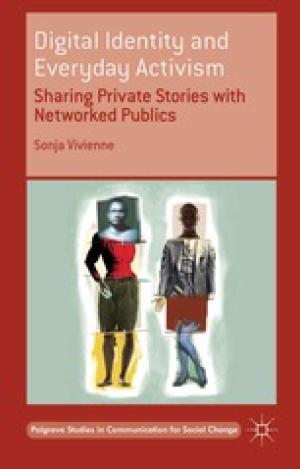
This small book is a brilliant example of grounded research that is thoroughly infused with theoretical insight and practical engagement. At first glance people looking for pedagogical wisdom might not be attracted by the title, but at the center of the book are questions of identity and everyday activism – topics that are vitally important in the midst of higher education contexts permeated with fears of “coddling students” and arguments over the value of “trigger warnings.” Vivienne is based at Flinders University of South Australia. This book draws on her background in media production and working with marginalized communities towards social change, and focuses on research she did with GLBTQ communities learning how to create in a specific form of digital storytelling: Digital stories are short (3-5 minutes) rich media autobiographical videos, combining personal photographs and /or artworks, narration, and music. They are traditionally created in a workshop context that takes place over 3-4 days and includes a story circle, technical instruction, and celebratory screening for fellow storytellers and invited guests. (3) Because persons within GLBTQ communities must constantly negotiate how they represent themselves, when and how they claim specific forms of identity, and in what ways they make these claims publicly, digital storytelling offered a compelling medium for a research project interested in exploring the challenges of sharing private stories with networked publics. The book is full of descriptions of how these stories emerged, with links to specific videos referenced available online. Vivienne’s work is both participatory and activist in methodology, drawing on the theoretical work of scholars such as Benhabib, Butler, Young, boyd, Jenkins, Bahktin, and Foucault. She ensures that the complexity of these theoretical interventions are made vividly accessible by using them to attend to the conundrums of claiming identity in the midst of highly contested spaces. She highlights the capacity of digital storytelling for reaching across various forms of difference: bridge building is reflected in the capacity to negotiate one’s position as a part of or apart from networked publics – including familiar, intimate, counter, and unknown. Digital storytelling creates opportunities to ‘bring things up,’ to broach difficult discussions ‘out in the open.’ Ownership of one’s position in society (as represented in a digital story) is reflected in the capacity to receive and give affirmation. Further, public expression of marginalized voices opens space for others to speak as they also negotiate how and where they fit in the world. As a medium that facilitates speaking across difference and bridge building, digital storytelling evokes the profound significance of participatory media as a widespread global phenomenon. (196-197) Along the way she defines and describes digital storytelling, everyday activism, erosive social change, and a concept she names “Intimate Citizenship 3.0,” as well as exploring issues of identity, nominalization, authenticity, coherence, and congruence in such media. Her research concludes with four specific findings: Institutions and facilitators can be transparent in actively acknowledging their discursive mediating influence upon the construction of individual and collective identities. [A]wareness of networked identity work provides an opportunity to sculpt congruent rather than coherent narratives and this labour can have both personal value and constitutive cultural value. [A]ctive consideration of distribution of private stories amplifies personal and social benefits, especially as a tool for everyday activism. [I]nitiatives benefit from reflective analysis of cross-disciplinary community engagement strategies, social movement theory, and strategic listening across difference. (205-206) While this book does not directly highlight pedagogies for religious studies or theology classrooms, it is full of stories in which workshop participants confront and contest religious claims their families, their communities, and broader “imagined” publics are making. By offering compelling descriptions of ways to engage such meaning-making that invite people into dialogue across various divides, this book embodies transformative adult learning and offers a rich collection of pragmatic advice for nurturing such learning.

I could not put this book down, and I strongly recommend that anyone concerned about higher education in America take it up. In this volume, Leonard Cassuto expands on topics he explores in his Chronicle of Higher Education column (“The Graduate Advisor”) and integrates them into an argument to reconceive the role and nature of teaching in graduate schools for the benefit of graduate students and higher education in general. What Cassuto means by “reconceiving” teaching at the graduate school level is something more fundamental than changing styles or methods of pedagogy. He wants faculty to help students succeed, personally and professionally, by seeing careers outside academia as worthy of professional pursuit. This is not, Cassuto repeats, a betrayal of graduate training, rather it is the retrieval of an earlier model of graduate education that envisioned doctorates serving in a broad variety of professional positions. In this, Cassuto differs from common approaches to “fix the mess,” such as calls to expand the ranks of professionally preferred and economically sustainable positions by converting part-time, non-tenurable ones to full-time, tenurable ones (for example, American Association of University Professors 2015-16 Annual Report on “The Economic Status of the Profession”). Cassuto argues, persuasively, that this will not come to pass. The days of every freshly minted PhD stepping into a full-time, tenure-track job belongs to the past; specifically, the period between the end of WWII and the close of the 1960s. In the history of American higher education woven throughout the book, Cassuto establishes that the unique circumstances of that period led to those halcyon days for those aspiring to the professorship. Changes in demographics and policies (educational and public) force us to abandon hope of this returning and instead imagine, again, a more expansive job market for those with doctorates. Towards this end, Cassuto recommends that from first contact with a prospective student through every stage of advising, faculty speak openly of the dismal academic market and approvingly of “alt-ac” careers. The chapters are arranged around the “life-cycle” of a graduate student (Admissions, Classwork, The Comprehensive Exams, Advising, Degrees, Professionalism, and The Job Market Reconceived) and offer concrete recommendations on how to adjust each of these phases in ways that will serve graduate students, graduate education, and by extension, undergraduate education and public life. The discrete changes he advocates (such as ways to reduce time to degree completion and alternate models of comprehensive exams and dissertations) are not original, but situating them within an enlarged concept of the possible uses of a doctorate is. An expanded concept of the potential purposes of the doctoral degree requires a significant change of attitude among graduate school faculty; they must sincerely support, and at times initiate, student embrace of career paths that do not resemble their own. Jobs in high schools, in business, in government, and so forth, must be accorded the same respect as full-time, tenure-track positions. This attitude shift will be, I venture, more challenging than Cassuto acknowledges. Cassuto is correct that this shift requires faculty to grasp, and leverage, the oversized role they play in their students’ lives. Interviews and anecdotes poignantly remind readers that the trust and admiration graduate students extend to their advisors may result in students shying from decisions that are in their own personal and professional interests for fear of disappointing their advisors. The prejudice that only a career in academia is worthy of doctorates exacts a tremendous toll on students. They sacrifice years, foregoing earnings and retirement savings, while accumulating debt and enduring personal and professional limbo. Cassuto rightly characterizes this as a “moral” crisis demanding action.
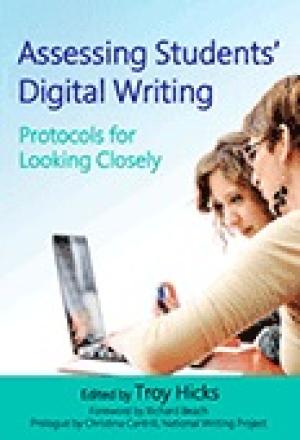
Assessing Students’ Digital Writing: Protocols for Looking Closely collaboratively addresses teachers who want to know about how to give feedback on digital writing. The book provides six digital writing protocols used to give feedback to teachers about student learning. The authors of the protocols are teachers themselves; Erin Klein, Julie Johnson, Jeremy Hyler, Bonnie Kaplan, Jack Zangerie, Christina Puntel and Stephanie West-Puckett wrote this book as a part of the National Writing Project in Berkley, California. Each teacher in this project uses a digital format to teach a specific lesson. At the end of each chapter the teacher discusses the implications of the digital process for instruction and assessment. At the end of the book the editor discusses broad themes and issues about curriculum, instruction, and assessment. This discussion is based on the study of student work in the writing as shared through conversations among the various authors and teachers of the project. As stated earlier, this book is a collaborative work and evidence of this is seen throughout each chapter. A weakness of the book is that it may be difficult for those who are just entering into digital writing because of the use of many technical terms associated with web-based learning. Although in general I find this book very valuable for gaining a better understanding about digital learning, I would like to see more information about the students who were part of the writing. The book is intriguing because of its focus on youth and their learning through digital writing methods. It is also timely in that it gives rise to more conversation about the remnants of the No Child Left Behind era and the very present views on Common Core State Standards that are sweeping across K-12 public education in the United States. Additionally, the rise of many digital formats for classroom teaching gives one reason to take the book seriously. As the author points out, this conversation is even more in vogue because of the accessibility of teachers and students to web-based services such as Google Docs, Wikispaces, and Voicethread. All of these services can be accessed on digital devices that are mobile. I can personally relate to what the authors are saying because I am presently teaching in an online platform that pushes me to look at digital writing very seriously. Furthermore, the book is interesting because the voices of the teachers in conversation about student learning are present throughout the book. I find this to be important in a time when much effort is made to assess student achievement where it seems student learning is not at the core of the assessment concern, although on the surface it may seem to be. Overall, this book is a valuable asset especially for those interested in assessment and digital writing.
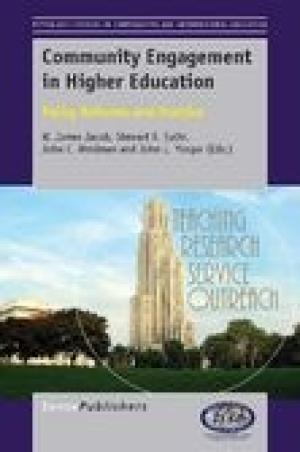
Towards the end of their introductory chapter, the editors of Community Engagement in Higher Education succinctly state the broad concern holding the volume together: “More emphasis should be made to link teaching and research with community initiatives” (17). The remaining seventeen chapters show what this can look like across a variety of higher education institutions, from community colleges to urban universities and from regional systems to global partnerships. Though divided into three parts – thematic issues, U.S., and international cases – the basic approach throughout the volume is descriptive case study written by persons with firsthand knowledge of the specific program or community engagement initiative. So, for example, contributors to part one raise “thematic issues” by reflecting on particular cases of the role of technology in enhancing university-community partnerships or service learning in disaster recovery. Similarly, scholars in parts two and three identify thematic issues in their interrogation of case studies focused on sustainable partnerships or the limits of current institutional commitments to critical community engagement. The subtitle of the book, “Policy Reforms and Practice,” suggests a more robust discussion of the way forward. However, most of the authors focus on their own institutional practices, relegating the larger questions of education policy reform to brief historical overviews of policies (such as the Morrill Act) and commissions (for example, the Kellogg Commission) that have served to legitimate the community engagement role of higher education. Given the parochial focus of individual chapters, the absence of a concluding, forward-looking synthesis chapter is conspicuous – even more so given the increasingly narrow metrics employed to measure the value of higher education institutions and persistent suspicion about the value-added of service learning. As many of the chapters remind readers, community engagement is not new, and many institutions support a range of initiatives. But therein lies the rub. In one of the strongest chapters – theoretically and practically – Seth Pollack critiques the “pedagogification” of service learning, a process through which service learning becomes primarily a method for teaching traditional content, rather than an “epistemologically transformative educational practice” aimed at forming students for critical civic engagement (170). Pollack’s chapter stands out as one of the few in the volume to find the sweet spot in case study research, using the case to illustrate theory and theory to illumine both the case and the wider social context in which the case is situated. Unfortunately, many of the other chapters do little more than report out on initiatives in which the authors played a significant role. As a result, the volume struggles to assert critical leverage in two important ways: self-critique and social critique. That is, the chapters would benefit, on the one hand, from a bit more critical distance from the programs discussed and, on the other hand, from critique of the wider social forces and structures that significantly shape the societal fault lines along which most community engagement initiatives are carried out. Taken together, the various case studies suggest that two challenges consistently threaten the success of community engagement: (1) alignment of both resources and vision between a large educational institution and diverse community stakeholders and (2) integration of the community engagement function into the identity of the university. A fair amount has been written in the past five years about the role of universities as anchor institutions, or institutions that are embedded in a particular place and committed to leveraging their resources and the community’s assets for community development, neighborhood revitalization, and so forth. The discussion of anchor institutions has catalyzed a conversation about both of the pressing challenges noted above, offering up a way to think about community engagement as more than just one-off service learning experiences or the aggregate of individual student volunteer hours. Yet, the volume has little to say about this current conversation. I looked forward to this volume, in part because we had just begun a conversation about how our small, religiously affiliated university could be a better neighbor to those in and around our campus. For those teaching religion and theology, such conversations are opportunities to draw from the deep well of religious reflection on who our neighbor is and what our obligations to one another might be – individually and as institutions. This conversation is not on the radar for the contributors in this volume, an omission that may have to do with the particular interlocutors in the Pittsburgh Studies in Comparative and International Education book series of which this book is a part. (The case studies are drawn primarily from public institutions, with the exception of a chapter on Duquesne University.) Yet religiously affiliated universities are often located in urban centers facing considerable challenges or negotiating difficult transformations. And these institutions articulate a purpose that, in mission statements, at least, resonates with the distinctive moral arc of public serving universities in the United States. These colleges and universities are also often anchors in many small town and rural communities, both of which merit more attention than is afforded in this book (as well as in the broader community engagement literature). I would be remiss if I didn’t mention one final concern: the appearance of sloppy scholarship in many of the chapters, beginning in the editors’ introduction. Issues include misidentifying the town in which a university is located, to quotations without citations, to grammatical errors. These could, perhaps, be dismissed as the collateral damage of publishing in an era with limited copy editing support. However, in light of the constant need many of us feel to defend community engagement and service learning as rigorous, such writing style concerns bear additional weight insofar as they detract from the credibility of those whose commitment to scholarship for social change can – and should – be a catalyst for revitalizing the service mission of higher education institutions.
Wabash Center Staff Contact
Sarah Farmer, Ph.D
Associate Director
Wabash Center
farmers@wabash.edu